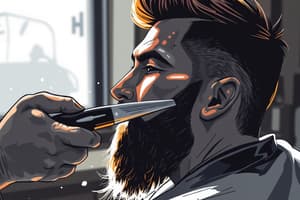Podcast
Questions and Answers
What is the razor position in the stroke used in 4 of 14 basic shave areas?
What is the razor position in the stroke used in 4 of 14 basic shave areas?
- Reverse backhand
- Cutting stroke
- Freehand stroke
- Backhand stroke (correct)
What is the procedure of shaving facial hair against the grain called?
What is the procedure of shaving facial hair against the grain called?
Close shaving
What is the correct angle of cutting the beard with a straight razor?
What is the correct angle of cutting the beard with a straight razor?
Cutting stroke
What is the first part of the standard shave consisting of the 14 areas of the face called?
What is the first part of the standard shave consisting of the 14 areas of the face called?
The neck shave involves shaving behind the ears down the side of the neck.
The neck shave involves shaving behind the ears down the side of the neck.
What type of mustache is suitable for a man with an extra large mouth?
What type of mustache is suitable for a man with an extra large mouth?
What should you do with the razor angle relative to the skin surface?
What should you do with the razor angle relative to the skin surface?
What is the term for the procedure that follows a regular shave to remove rough or uneven spots?
What is the term for the procedure that follows a regular shave to remove rough or uneven spots?
Match the shaving techniques with their descriptions:
Match the shaving techniques with their descriptions:
Do not proceed with the shave service if the client has _____.
Do not proceed with the shave service if the client has _____.
What determines hairline shapes?
What determines hairline shapes?
What should you do to the client's hair growth pattern before beginning the shave?
What should you do to the client's hair growth pattern before beginning the shave?
Which of the following is an anti-hemorrhagic?
Which of the following is an anti-hemorrhagic?
The shaping movement from the angle of the mouth towards the chin is referred to as backhand and down.
The shaping movement from the angle of the mouth towards the chin is referred to as backhand and down.
What type of stroke should be used around the mouth and in tight areas?
What type of stroke should be used around the mouth and in tight areas?
Lathering with a shaving cream or gel cleanses the skin and _____.
Lathering with a shaving cream or gel cleanses the skin and _____.
What type of skin allows beard hair to be cut more easily?
What type of skin allows beard hair to be cut more easily?
What is the most successful cutting technique on beards with even density and texture?
What is the most successful cutting technique on beards with even density and texture?
Do not stop short or shave over an area repeatedly.
Do not stop short or shave over an area repeatedly.
Flashcards
Backhand Stroke
Backhand Stroke
A stroke with the razor used in four out of 14 basic shave areas; optional for area 12.
Close Shaving
Close Shaving
Involves shaving against the grain during a second pass to achieve a smoother finish.
Cutting Stroke
Cutting Stroke
Correct angle of the blade while cutting facial hair with a straight razor.
First Time Over Shave
First Time Over Shave
Signup and view all the flashcards
Freehand Stroke
Freehand Stroke
Signup and view all the flashcards
Neck Shave
Neck Shave
Signup and view all the flashcards
Once Over Shave
Once Over Shave
Signup and view all the flashcards
Reverse Backhand
Reverse Backhand
Signup and view all the flashcards
Reverse Freehand
Reverse Freehand
Signup and view all the flashcards
Second Time Over Shave
Second Time Over Shave
Signup and view all the flashcards
Styptic Powder
Styptic Powder
Signup and view all the flashcards
Mustache Shapes - Heavier
Mustache Shapes - Heavier
Signup and view all the flashcards
Mustache Shapes - Medium-Large
Mustache Shapes - Medium-Large
Signup and view all the flashcards
Mustache Shapes - Narrow to Medium
Mustache Shapes - Narrow to Medium
Signup and view all the flashcards
Mustache Shapes - Pyramid
Mustache Shapes - Pyramid
Signup and view all the flashcards
Mustache Shapes - Medium Short
Mustache Shapes - Medium Short
Signup and view all the flashcards
Mustache Shapes - Small Triangular
Mustache Shapes - Small Triangular
Signup and view all the flashcards
Mustache Shapes - Handlebar
Mustache Shapes - Handlebar
Signup and view all the flashcards
Mustache Shapes - Semi-Square / Linear
Mustache Shapes - Semi-Square / Linear
Signup and view all the flashcards
Study Notes
Shaving Techniques and Definitions
- Backhand Stroke: A stroke with the razor used in four out of 14 basic shave areas; optional for area 12.
- Close Shaving: Involves shaving against the grain during a second pass to achieve a smoother finish.
- Cutting Stroke: Correct angle of the blade while cutting facial hair with a straight razor.
- First Time Over Shave: Consists of a standard shave covering 14 facial areas, followed by a second pass.
- Freehand Stroke: A specific razor position employed in six of the shave areas (1, 3, 4, 8, 11, and 12).
- Neck Shave: Shaving occurs behind the ears, down the sides of the neck, and at the nape.
- Once Over Shave: A single lathering technique where strokes are made across the direction of hair growth.
- Reverse Backhand: Used by right-handed barbers for the left side of the neck and left-handed for the right side.
- Reverse Freehand: Specific stroke position used in four shave areas (5, 10, 13, and 14).
- Second Time Over Shave: A re-shave after the initial pass, using water to smooth any rough spots, considered a close shave.
Facial Hair Design
- Styptic Powder: Alum powder used to stop bleeding from minor cuts or nicks during shaving.
- Mustache Shapes:
- Heavier looking mustaches complement larger features.
- A medium-to-large mustache suits individuals with prominent noses.
- A narrow to medium mustache is ideal for a long narrow face.
- Pyramid-shaped mustaches suit those with extra-large mouths.
- A medium short mustache works well with extra small mouths.
- Smaller triangular mustaches fit individuals with small regular features.
- Heavier handlebar mustaches work for those with a wide mouth and prominent upper lip.
- Semi-square and heavier linear mustaches are advisable for balanced facial shapes.
Shaving Procedure and Safety
- Steps of Professional Shave: Includes draping, hot towel preparation, and steaming the face prior to shaving.
- Avoid Immediate Post-Shave: Deep cleansing facials should not be performed directly after shaving.
- Preparation: Shaving begins with softening the beard using hot towels.
- Client Condition: Do not proceed with the shave if the client presents with pustules or skin infections.
Skin and Hair Considerations
- Facial Hair Growth: Analyze hair growth patterns to determine the grain for an effective shave.
- Ingrown Hairs: Often a result of improper hair removal techniques, also known as pseudofolliculitis.
- Irritation Prevention: Stretching the skin too tightly or using hot towels on sensitive skin can lead to irritation.
Shaving Tools and Techniques
- Razor Position: Maintain a 30-degree angle to the skin surface for optimal cutting.
- Touch Method: Use light pressure for shaving to avoid excessive irritation.
- Shaving Movement: Employ shorter strokes around the mouth and tight areas.
- Massage and Moisturizing: Finish the shave by massaging moisturizer into the skin for hydration.
Hygiene and Disposal
- Sharps Disposal: Used razor blades should be discarded in designated sharps containers.
- Skin Moisture: Keep the skin moist during shaving to facilitate the shaving process.
Post-Care Guidelines
- Final Treatment: Complete shave services with hot towels and facial lotion for relaxation and skin care.
- Skin Type Consideration: Use pH balanced toners or fresheners for optimal post-shave treatment.
- Avoidance Rules: Do not stop short of shaving an area or repeatedly shave over the same spot to prevent irritation.
Studying That Suits You
Use AI to generate personalized quizzes and flashcards to suit your learning preferences.





